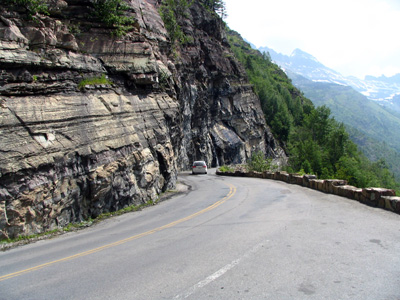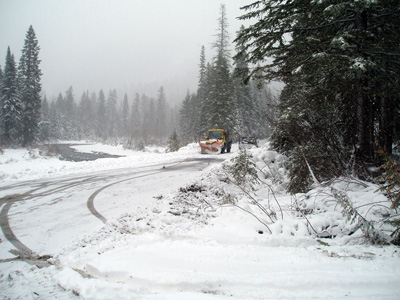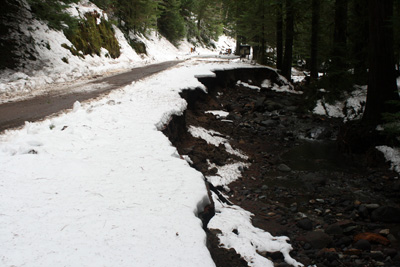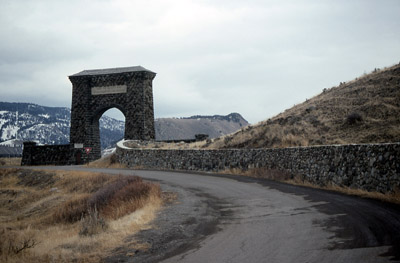
Road maintenance critical for parks
Of the 390 national parks in the United States, almost all of them, with the exception of 12, depend on ground access.
Originally, the official stance of the U.S. Department of the Interior was that no automobiles would be allowed in the national parks. That all changed in 1907 when, after some debate, Hot Springs National Park in Arkansas allowed automobiles and changed the way visitors experienced national parks.
 |
The famed “Going to the Sun” highway provides amazing views in Glacier National Park in Montana (Photo courtesy of the National Park Service). |
The National Park Service Transportation Mission is to “preserve and protect resources while providing safe and enjoyable access within the national parks by using sustainable, appropriate, integrated transportation systems,” according to the NPS 2003 Program Overview that is published on the NPS Web site.
The National Park Service Park Roads and Parkways Program is jointly administered by NPS and the Federal Highway Administration. Although the program was not officially established until 1982, cooperation began in 1926 with the construction of the famed “Going-to-the-Sun” road in Glacier National Park in Montana.
NPS is responsible for protecting the parks and for setting the priority of projects. The Federal Highway Administration provides engineering expertise, is responsible for program oversight and is the formal voice to Congress.
According to the Interagency Agreement NPS shall develop park road designs, construction, maintenance, and safety standards.
The FHWA has three division offices across the country whose highway engineers are responsible for the rehabilitation plans, inventory, and assessment of park roads.
| A truck plows snow along the “Going to the Sun” road in Glacier National Park in Montana (Photo courtesy of the National Park Service). |  |
Despite recent legislation to increase funding for the repair and maintenance of the transportation system, Jim Evans, Alternative Transportation Program manager for the NPS Headquarters in Washington D.C. said that money is still their biggest challenge.
“We receive our money from the Highway Trust Fund, which comes from the 18 cents you pay at the gas pump and that money is being distributed to all the state agencies. We have a lot of players that are asking for money from those $30 billion a year,” Evans said.
The Highway Trust Fund was originally established by the Highway Revenue Act in 1956 and dedicated by Congress to be spent on highway and transit needs. The bill was set to expire in 1972 but was extended through September 2005.
The funding level for the Park Roads and Parkways Program from those two Highway Trust Fund Authorizations caused the system to deteriorate at one to three percent annually, according to the NPS 2003 Program Overview.
This condition was stabilized in 1998 when President Clinton signed the Transportation Equity Act for the 21 Century (TEA-21) into law. The Park Roads and Parkways Program currently receives $165 million annually under the TEA-21.
In addition, President George W. Bush signed the Safe, Accountable, Flexible, Efficient Transportation Equity Act: A Legacy for Users (SAFETEA-LU) into law on Aug. 10, 2005, which will provide over $286 billion over five years for surface transportation programs.
“From SAFETEA-LU we’ll get $1.1 billion in surface transportation legislation from 2005 through 2009, but our maintenance needs are four times that amount,” Evans said.
 |
Snow on the roadside at Mount Rainier National Park in Washington (Photo courtesy of the National Park Service). |
With 8,500 miles stretching through the park system “there is a long list of desired road repairs and we work at those as the money becomes available,” Jeff Olson, NPS Public Affairs Officer in Washington, stated.
According to the NPS currently “65 percent of all NPS roadway pavements are in unacceptable condition.”
With so many necessary repairs and limited funds, one wonders where the money goes first.
“Health and safety are at the top of the list of priorities,” Olson said.
Evans concurs adding “the roads that serve the greatest number of visitors have priority, some of our most visited parks like Yosemite, Great Smoky Mountains and Yellowstone National Park.”
According to Olson, there are provisions for emergencies in the budget.
“There were some big storms in the pacific west last winter and there are emergency funds that we can tap in to for those,” he said.
One park hit hard in 2006 was Mount Rainier National Park in Washington. On Nov. 7, the park experienced the largest flood of its 108-year history, receiving almost 18 inches of rain in 36 hours. The estimated damage exceeded $36 million and it is expected to take years to complete repairs.
Mount Rainier remained closed through the spring of 2007, with some potential opening of roads in early to mid May. More than 11 main roads were forced to be shut down due to the flooding, some for the season and others permanently.
 |
The massive entrance archway and road at Yellowstone National Park in Wyoming (Photo courtesy of the National Park Service). |
“The highway bill sets aside a certain amount of money for roads each year. If there is too much wear and tear then our repairs outstrip the sources of money,” Olson said.
Although there is no way to control Mother Nature, the NPS is doing its best to ease the human wear and tear on the park roads and parkways.
“We now have in 99 park units over 116 alternative transportation systems. They range from large busses to smaller vans to trams to rubber wheel trolleys. We even have some big trains like in Cuyahoga Valley, Ohio,” Evans said.
These alternative modes of transportation are not only good for the parks, but for visitors as well. Evans said that this allows visitors to share their experiences with each other.
“They like it once they start using it. One of the most interesting comments we get is that people enjoy these transit systems because it gives them an opportunity to talk with other visitors.”

Comments are Closed